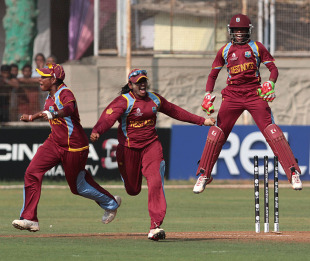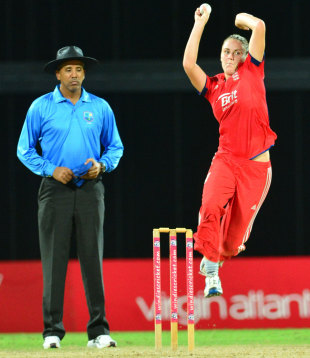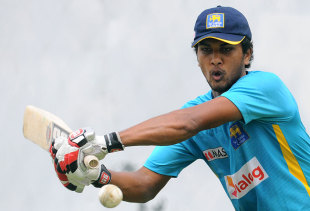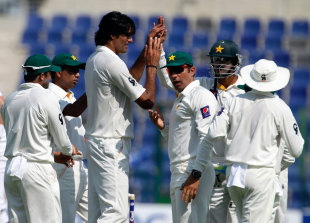In the women's game, West Indies, Pakistan and Ireland stamped their authority on the field, while Australia, New Zealand and South Africa made significant progress off it
Raf Nicholson December 28, 2013

West Indies beat higher-ranked teams and made it to their first World Cup final © ICC/Solaris Images
The Women's World Cup in India proved an exciting start to 2013, generating unprecedented media coverage and catching the public's attention as never before: 23.7 million people globally watched the broadcast group matches. On the pitch, the tournament produced some of the biggest upsets ever seen in international cricket: Sri Lanka, who had never previously beaten any of the top-four-ranked teams (England, Australia, New Zealand and India), triumphed in two of their group matches. India were dispatched by a crushing 138 runs; and though their match against the defending champions, England, came down to a last-ball nail-biter, Eshani Kaushalya's 56 off 41 balls ensured a famous one-wicket victory.
To top it off, West Indies, who had never beaten Australia or New Zealand before in the 50-over format, managed to win their group matches against these teams and top the tables in the Super Sixes stage. Deservedly, they went on to feature in their first World Cup final - a final that had previously always featured two of those top four teams. Australia proved far superior on the day, with Ellyse Perry's 3 for 19 helping them bowl West Indies out for 145, but history had already been made.
Australia's ninth World Cup victory was a fitting end to the career of their star allrounder Lisa Sthalekar, who announced her retirement in the wake of the tournament. With 2728 ODI runs at 30.65 and 146 wickets at 24.97, Sthalekar is the only woman ever to score 1000 runs and take 100 wickets in ODIs, and the end of her 12-year career marked the end of an era for Australia's Southern Stars.
But it was New Zealand's captain, Suzie Bates, who averaged 67.83 with the bat and hit a century against champions Australia in the group stages, who was named Player of the Tournament - and, more recently, the ICC's Women's ODI Player of the Year. In April, Bates also became one of the first Kiwi women players to be awarded semi-professional contracts by New Zealand Cricket, along with Sophie Devine, Sian Ruck and Sara McGlashan.
South Africa also introduced contracts for its female players for the first time this year; and an important step was taken towards full professionalism in the women's game when, in the wake of the World Cup triumph, Cricket Australia restructured their contract system, making it possible for leading Australian players to earn up to $80,000 annually. All eyes are now on the ECB, wondering if it will soon follow suit.
The ICC took steps to continue the global expansion of women's cricket, announcing that the women's World Twenty20 would be expanded to incorporate ten teams, instead of the previous eight. This allowed three teams to progress from the qualifying tournament, which took place in Ireland in August, and means that the 2014 tournament will feature Pakistan, Sri Lanka and Ireland, as well as hosts Bangladesh.
Indeed, it proved to be a good year for the underdog. In April, Bangladesh toured India for the first time, to play in three ODIs and three T20Is (though they lost all six matches). Pakistan showed the progress they have made when, on their first tour of England in July, they beat England Academy and achieved their first win against England in any form of the game in the second T20, in Loughborough, winning by one run. The players were each rewarded with a $1000 bonus by the PCB.
And then, of course, there was that biggest of cricketing innovations: a new-format women's Ashes, with the winner decided based on points awarded across all three formats - Tests, ODIs and T20s. A resurgent team effort by England saw them triumph by 12-4 on points after the single Test match was drawn, though the performances of Katherine Brunt with the ball - nine wickets at an economy of 3.02 across all formats - along with Heather Knight's majestic 157 in the Test, and Sarah Taylor's average of 38.42 with the bat, and flawless keeping ability, were truly special. Taylor was deservedly awarded the ICC Women's T20I Cricketer of the Year on the back of this series.
Perhaps equally importantly, the new format generated a great deal of excitement and media attention, with the BBC broadcasting all matches live for the first time. Coupled with the furore surrounding the World Cup, then, 2013 has been an exciting year for women's cricket.
High point
The final of the World Cup, which was watched globally by 50 million people. That, and the accompanying Twitter explosion, proved definitively that there is interest in and a worldwide audience for women's cricket.
The interest surrounding the women's Ashes series reinforced this point. Arguably the new points-based system may prove to be a means of reviving the longer format in countries whose cricket boards have so far rejected women's Tests as commercially unattractive.
Low point
The eviction of the women's World Cup matches from the Wankhede Stadium at the last minute to accommodate two men's domestic games. The programme of matches was not eventually finalised until five days before the opening game, which was unsettling for the players and did nothing to help encourage local crowds. It proved an embarrassing gaffe by the ICC.

Natalie Sciver: the first England female player to take a hat-trick in T20Is © WICB
New kid on the block
Natalie Sciver is England's find of the last few years, a genuine allrounder who stormed onto the international scene for England back in July, taking 3 for 28 against Pakistan in only her second ODI. She has continued to excite; in the fifth match of the tri-series against New Zealand in October, she became the first Englishwoman to take a T20I hat-trick. Her contributions with the bat have also been impressive: she averaged 100 during the Ashes. At 21, she is sure to be a mainstay of the England side for the next few years.
All eyes will also be on Holly Ferling when the women's Ashes starts January 10. At just 17 years of age, she made a surprise debut back in February at the World Cup when Perry was out of action. Her sheer pace blew England away; she took 3 for 35 and England sank from 37 for 2 to 39 for 6 and lost the match by just two runs. Though still raw and erratic, she shows great promise for the future.
What 2014 holds
The year kicks off with the follow-up women's Ashes series in Australia in January, which will see a return to the multi-series format that proved so successful over the summer in England. It will be interesting to see how far the interest this new format previously generated carries over into this series.
The big event of the year will be the World Twenty20 in Bangladesh, to be staged once again in conjunction with the men's tournament. Australia will be favourites to defend their title, but a West Indies team buoyed by their good performances in 2013 - they triumphed in the tri-series against New Zealand and England in October - will be keen to reach their second successive tournament final. With Deandra Dottin and Stafanie Taylor at their disposal, they might just pull off a victory, too.














